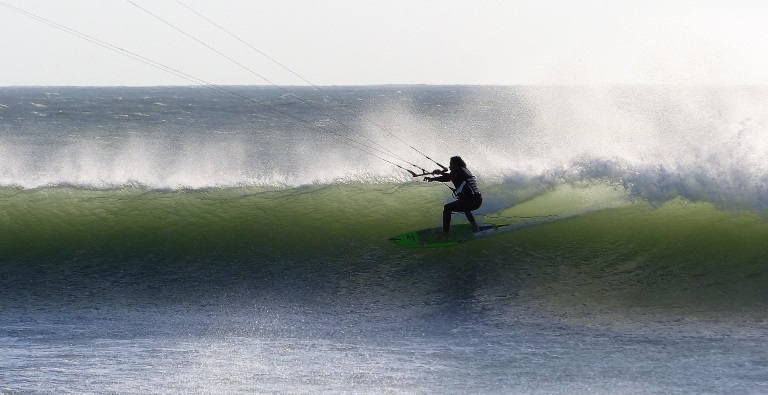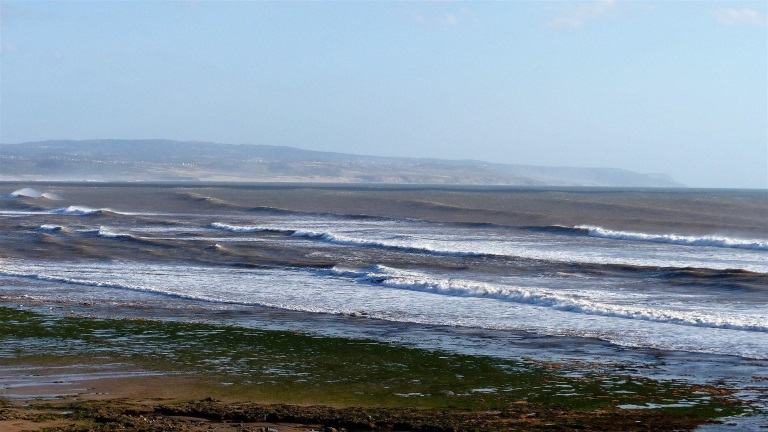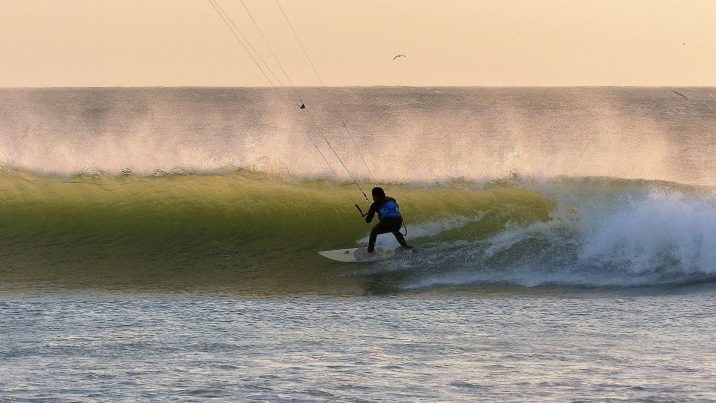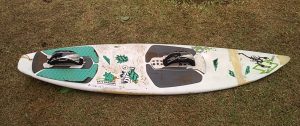Whether you’re a seasoned or newer wave rider, traveling to a top-quality wave kitesurfing spot will both build up your skills and take the excitement, adrenaline, and riding experience to new levels.
There are obviously hundreds of spots with waves and wind that you can ride, but not that many of those special places that bring together all the right conditions, making for the ultimate kitesurfing stoke. Here is my personal pick of 10 best wave kitesurfing spots on the planet:
- One Eye (Le Morne, Mauritius island)
- Oum Labouir (Dakhla, Morocco)
- Pacasmayo (Peru)
- Ponta Preta (Sal, Cabo Verde)
- Hookipa/Lane’s (Maui, Hawaii)
- Punta San Carlos (Baja California, Mexico)
- El Medano (Tenerife, Canary Islands)
- Caños de Meca (Cadiz, Spain)
- Lavanono (Madagascar)
- Sidi Kaouki (Essaouira, Morocco)
Before we look at the spots, let me first clarify what I mean by best wave kitesurfing spots.
What makes a good wave kitesurfing spot
What constitutes a top wave kitesurfing spot boils down to wind quality and wave quality. You want a place that has constant wind for hours and hours every day and days on end. You want the wind to be strong enough to be riding on a kite no larger than 9m (5, 7, 9) most of the time.
Most importantly though, you want relatively steady wind as gusty wind can really mess up your riding experience. As for direction, side-shore (parallel to the beach) or slightly offshore (towards the sea) wind usually makes for the best wave riding kitesurfing experience.
What about the waves? The spot should have long-distance, groundswell-driven (vs wind-driven) waves, with a long period between sets making for smoother riding surface and better shaped, more regular, more powerful sets.
Like surfers, for wave
The ideal wave shouldn’t be huge, 1.5m to 2m is often considered a perfect size for both surfers and kitesurfers (though some riders like the rush of bigger waves). Size aside, what matters most is length, regularity, and power.
If like me, you live near the ocean, you may get a nice wave kitesurfing session once in a while, if and when swell and wind conditions converge. In contrast, when traveling to a top-quality wave kite spot, you’ll be pretty much guaranteed to have a bunch of great sessions over a relatively short stay, allowing you to really get into the riding and improve your skills.
Top wave kitesurfing spot #1: One Eye / Manawa – Mauritius Island
Le Morne is a well-known beach, point and lagoon in the Southwest part of Mauritius island. As a reminder, Mauritius is a tiny island located in the Indian Ocean East of Madgascar and the East cost of Africa.
One Eye is the name of the island’s most famous wave, a left-hander that breaks on a reef outside of the Le Morne lagoon. It’s one of the cleanest and fastest waves in the world. The wind is also very reliable (300 wind days per year) as the mountains accelerate the trade winds.
Kitesurfers ride the wave between the Manawa and One Eye reefs – the One Eye reef is mostly reserved for paddle surfers. This is a spot for advanced wave kitesurfers! There is offshore wind, reefs sticking out, big waves, strong currents, and occasional sharks due to the lagoon’s multiple passes.
If you have the skills, though, it’s a memorable wave to ride. There are also a few other wave spots outside the lagoon.
Check out this page for some of the best kitesurf camps in Mauritius
Top wave kitesurfing spot #2: Foum Labouir – Morocco

Oum
Oum Labouir boasts high-quality, steady wind and long waves. The wave is very long and clean, with occasional barrels by Northeast sideshore wind. the wave gets better as it gets bigger and can hold up to 3m.
The spot gets most wind in the spring and summer (April-September) while the big swells that bring 1-2m waves occur mostly in the fall and winter time (September-May).
Therefore you do need a bit of luck / good timing to strike both wind and swell concurrently. At the very least, though, you’ll find some small waves to kitesurf and/or some great waves to paddle surf when the wind is light.
The Dakhla lagoon on the other side of the peninsula is a fantastic site surrounded by desert, a renowned zone for steady wind, flat water kiting, and awesome downwinders.
Ocean Vagabond is the most highly-rated and high-end (yet nature-oriented and environment-friendly) kitesurf camp on the lagoon in Dakhla, being a pioneers of kitesurfing there. Check out their 4-day and 7-day kitesurf and yoga package.
Top wave kitesurfing spot #3: Pacasmayo – Peru
Pacasmayo is a village about half way between Lima and Peru’s Northern border with Ecuador. It’s often considered one of the longest kitesurfing waves in the world, peeling regularly over a couple hundred meters.
The wave is perfect, very well formed, not too powerful at medium size, making it really fun to ride and progress on. It can be kitesurfed up to 4m. The best conditions are South or Southwest swells and Northeast wind.
The best wind season is April to November, wind reliable wind every day building up to 18-20 knots mid-day.
The wind is typically side / side-off, which contributes to making the wave so clean and smooth to ride on. On really offshore days you should only go out if you’re a confirmed rider or if there’s a rescue boat around. Other things to look out for are the rocks in the water and the strong currents.
See this page for some of the best kitesurf camps in Peru.
Top wave kitesurfing spot #4: Ponta Preta – Cape Verde
Located near Santa Maria, the capital of Cape Verde’s Sal Island, Ponta Preta is another one of the world’s fastest and most beautiful kitesurfing waves. The spot is home to Mitu Monteiro, one of the world’s best kitesurfers and legendary wave rider.
Being on the West coast of the Sal island, Ponta Preta catches the big Northwest Atlantic groundwells head on and gets big waves up to 6m, particularly between January and March.
The powerful wave breaks right on rocks, so unsuccessful take-off attempts can be costly in terms of gear and skin! This is essentially a spot for expert wave kitesurfers.
The beach by the point is rocky – though there’s a long sandy beach leading up to the point. With the swell comes a strong shore break, which makes getting out even more challenging.
The best winds are from November to mid-June resulting from the Northeast trade winds, with exceptionally steady wind around 15 to 22 knots. The dominant Northeast wind, however, comes in side-offshore – and even completely offshore on days of more Easterly wind.
Raw swell, big rocks, hard launch, offshore winds… You must really earn your paradise! If you’re not that much of a seasoned wave kitesurfer, you can find more mellow wave conditions elsewhere on the island, outside the Fragata lagoon, or at Santa Maria’s Punta do Leme Velho.
Check out these Cape verde kitesurf camps.
Top wave kitesurfing spot #5: Lane’s – Hawaii
This is a place for big waves and expert and professionals kitesurfers. The lifeguards want to know you before you go out. Not for the faint of heart! The big and powerful right-handers are super fast and break on the reef. The waves season is mainly from September to May.
Take-off is done on a small sandy beach with lots of rocks downwind and along the coast. You have to walk over a sharp reef with sea urchins to get out to the open ocean. Locals (including some of the best riders in the world) not only wear boots but also gloves and helmets.
The best wind for Kitesurfing is May to October (solid trade winds). The wind is typically side-off and gusty, making going out at this spot even more dangerous. The locals follow strict safety rules, and the lifeguards will fine you if you ride too close or drop your kite near someone, or if you drop on someone else’s wave.
If you’re not up to level for Hookipa/Lane’s when big swells hit, you can ride Kanaha for softer, safer yet fun waves in a nice bay with a sandy bottom, smooth water, and lots of flat water space downwind.
Click here to see a list of some the best kitesurf camps in Hawaii.
Top wave kitesurfing spot #6: Punta San Carlos – Mexico
Punta San Carlos is located on the West coast of the Baja California peninsula, on the other side from the Gulf of Mexico. It’s a desert place, usually empty, with no construction, just a few shacks and tents, 50 miles (a 2.5 hours drive on dirt roads) from the nearest town El Rosario.
The main wave kitesurfing spot is a stunning point that breaks quite far from the shore and tends to get a lot of wind as well as a world-class wave with a steep peak, typically as a result of Southwest and Northwest groundswells.
For less advanced riders, there’s also a nice beach break to kitesurf with mellow waves that get somewhat shielded from swells by the small island in front of the point.
The main wave from the point gets split in two by the island and becomes the “Chili bowl”, another nice peak closer to shore for kitesurfers and surfers to ride.
The wind blows all year, typically cross-offshore, often with strong thermal conditions. Wind tends to be gusty near the shore. The spot is suitable for mid-level wave kitesurfers due to the rocks and reef.
Check out some of the best kite camps in Mexico.
Top wave kitesurfing spot #7: El Médano – Canary Islands
This is a very popular wave kitesurfing spot on the Southeast part of the Tenerife island. El Médano used to be a fisherman’s village, though it’s been heavily built up and has become an important tourist destination of the island.
El Médano is a pretty deep bay bordered by the town and harbor in the North and a mountain in the South. Just take a look at this picture to see it clearly.
The kitesurf wave spot is where the harbor wall is, with nice clean waves forming with South Swells – they can get pretty big. You can kitesurf the waves any time except around high tide as the harbor wall causes heavy chop.
The wind is mainly Northeast, side-onshore on the beach but side-shore relative to the wave. It mainly blows between April and October (trade winds) but is strongest in the summer months. The wind is accelerated by the Teide mountain so it’s generally stronger than forecast, usually in the 15-35 knot range. It’s gustier near the shore due to the growing number of buildings.
The beach wraps around the central part of the bay, from the end of the buildings all the way up to the mountain at the other end, so there’s plenty of space to set up and launch. Bigger swells can create a strong shore break that you need to go through to get out.
The downwind area, where the mountain lies, has shallow rocks and no sand, so expect some hassle if you end up there. Also, avoid going outside the bay into the open ocean as there are very strong currents due to the mountains.
If you’re an advanced kitesurfer, you can hop over to El Cabezo, the adjacent bay to the North, for stronger winds and much bigger waves – but sharp rocks and shallow water.
Click here for a list of top kite camps of the Canary Islands.
Top wave kitesurfing spot #8: Caños de Meca – Spain
Caños is the main wave spot for Tarifa’s kitesurfing crowd. The spot is located in the bay bordered to the west by the historic Trafalgar point and lighthouse, about 40km north-west from Tarifa.
The bay and point’s orientation makes it safe to kitesurf in strong Levante (East / Southeast wind) when most other beaches in the area are blown offshore. The wind is normally a few knots slower than in Tarifa so kitesurfers escape here when the Levante gets over 30-35 knots.
With Levante, nice clean waves from the Atlantic form on a reef, head-high to much bigger (up to 3m) when groundswells hit. There’s often a shore break at high tide, and some rocks sticking out at low tide.
Around the lighthouse is a nice sandy beach where kitesurfers can set up and get into the water, while windsurfers tend to get out deeper in the bay where the buildings and rocks are.
Caños often will get very crowded when conditions are good, as all of Tarifa’s kitesurfers flock to the point.
See some of the best kitesurfing camps in and around Tarifa.
Top wave kitesurfing spot #9: Lavanono – Madagascar
Lavanono is one of the most isolated kitesurfing spots in the world. It’s located in a 500-soul fishermen’s village at the Southwestern tip of the Madagascar island, 20km from the island’s southmost point, Cap Sainte Marie, and 160 miles (an 8-hour drive on dirt roads) West of Fort-Dauphin and the Berenty nature reserve.
The spot has an exceptional point break wave kitesurfing spot, a fantastic peeling left that holds up the size. The trade winds blow from July to November, typically 15 to 30 knots every day from 10 am to 3 pm. The wind direction is side-off, perfect for wave kiting.
A less hardcore beach break with smaller waves and side-shore wind can also be surfed.
The wave
Check out some of the best kite camps in Madagascar here.
Top wave kitesurfing spot #10: Sidi Kouki – Morocco

Sidi Kaouki is a tiny village 15 miles South of Essaouira, with a point break at its Northern tip, a river mouth at its Southern tip, and in between, a very long and wide, sandy open beach that catches large North Atlantic swells very well. The biggest swells occur from October to April.
The Northeast trade winds are strongest between April and October and get accelerated by thermal differences between ocean and inland air temperatures. Wind usually starts around 11am-noon and keeps rising until late afternoon, frequently reaching speeds of 25-30 knots.
The waves are the cleanest around the North point (close to where the shrine and restaurants are) and at the South rivermouth (“oued de Kaouki”). The wind is often side-shore or slightly offshore in the morning and tends to turn onshore in the afternoon.
The waves in Kaouki are rarely as perfect as reef waves, but when the right swell and wind come in it offers some memorable wave kitesurfing sessions.
Behind the Kaouki point and all the way to the Ouassem village is a rocky stretch of coast with some very good wave breaks (Le Marabout, La Mouette, Tagenza). These can be ridden by more advanced kitesurfers as there are lots of rocks and often full offshore wind.
Check out the kitesurf camps in Sidi Kaouki.
A few tips for preparing for your next wave kitesurf trip
Before you plan your trip to a top wave kitesurf spot, you should at least basic have some minimum wave riding skills to make the most out of your kitesurf trip. Here are a few tips:
- Get a strapless directional kitesurf board and learn to carve S-turns, ride toeside, and jibe, first on flat water, then in small waves. See Tips for learning directional kitesurfing
- Find a kitesurf spot with small waves and onshore wind near you so as to build up your wave riding skills safely and confidently.
- If you can, try doing a downwinder in your area. Kitesurfing downwind helps you get better at wave riding by practicing turns on waves without worrying about staying upwind.
- Practice sliding over waves by bringing your kite up to lift you slightly to dampen the impact, and tackling the waves at an angle.
- For your first wave kitesurfing trip, try to pick a safe place, preferably a spot with a sandy beach and no nasty reef, ideally with
rescue . - If you can, get a surf skateboard to practice body rotation and compression for carving. See this post for more about surf skateboards.



